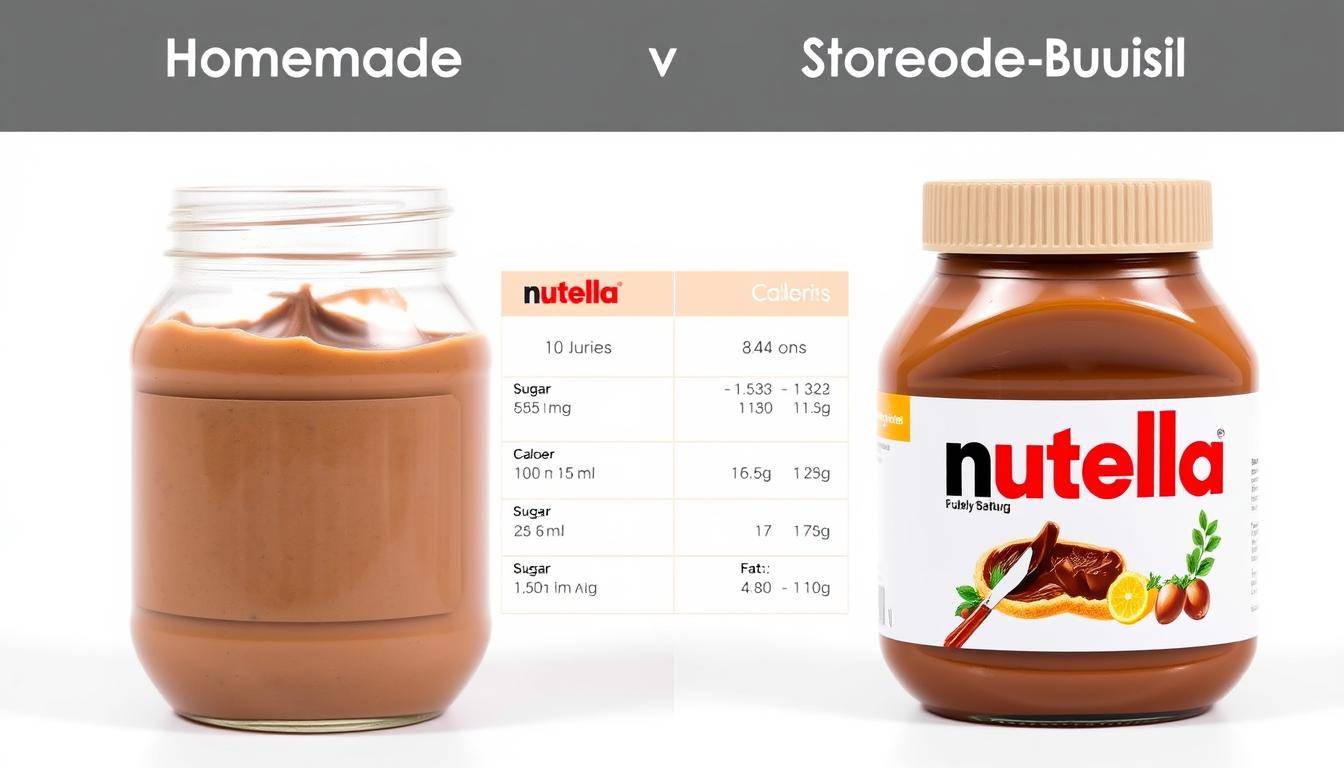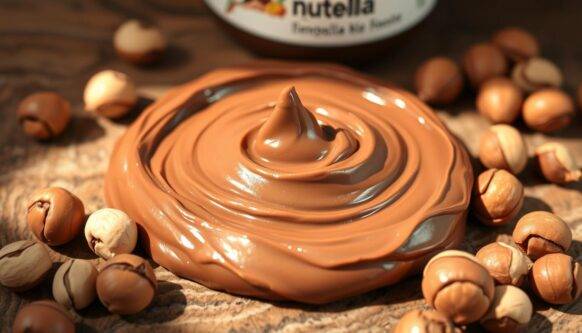Homemade Nutella Alternative: Easy Recipe
Homemade Nutella Alternative: Easy Recipe
We love the rich, chocolatey taste of Nutella, but sometimes we want a version that’s a bit healthier. That’s why we’re excited to share our easy recipe for a homemade chocolate hazelnut spread that’s just as delicious as the store-bought version.

This recipe is simple to make and requires just a few ingredients, including hazelnuts, cocoa powder, and sugar. We can customize it to our dietary needs and preferences, making it a great alternative to commercial spreads.
By making our own chocolate spread, we have control over the ingredients and can reduce the sugar content. This recipe is perfect for those looking for a healthier treat that’s still rich and satisfying.
Key Takeaways
- Easy to make with just a few simple ingredients
- Customizable to dietary needs and preferences
- Rich, creamy texture and deep chocolate flavor
- Healthier alternative to commercial chocolate spreads
- Control over ingredients and sugar content
Why Make Your Own Nutella at Home
While store-bought Nutella may be convenient, there are compelling reasons to make your own version. Commercial Nutella contains a significant amount of palm oil and sugar, making up more than 50% of the product.
The Problem with Store-Bought Nutella
Store-bought Nutella has several drawbacks. Two tablespoons contain 200 calories, 11 grams of fat, and 21 grams of sugar. The presence of artificial flavors and preservatives like vanillin may also be concerning for health-conscious consumers.
| Nutrient | Amount per 2 tbsp |
|---|---|
| Calories | 200 |
| Fat | 11g |
| Sugar | 21g |
Benefits of Homemade Hazelnut Spread
By making your own hazelnut spread, you can control the ingredients and sweetness level. This allows for adaptations to suit dietary needs, such as vegan, dairy-free, or low-sugar versions. Homemade Nutella can be made without palm oil, addressing environmental concerns. Additionally, freshly made hazelnut spread tastes superior to processed versions, and making it in bulk can be cost-effective.
Our homemade hazelnut spread recipe offers a healthier alternative to store-bought Nutella, with the flexibility to adjust ingredients according to your preferences.
Ingredients for Homemade Nutella Alternative
Creating a homemade Nutella alternative requires just a few simple ingredients. To make this delicious spread, you’ll need to focus on the quality of the ingredients you choose.
Essential Ingredients
The basic recipe for homemade Nutella includes several key ingredients. You’ll need 2 cups of hazelnuts (about 240g), which serve as the base of the spread. 1/4 cup of cocoa powder adds the chocolate flavor, while 1/3 cup of your chosen sweetener (such as sugar, coconut sugar, or maple syrup) balances the taste. Additionally, you’ll need 1/4 teaspoon of salt to enhance the flavors. To achieve the right consistency, you can use either 1/2 cup of milk (dairy or non-dairy) or 2 tablespoons of oil.
| Ingredient | Quantity | Purpose |
|---|---|---|
| Hazelnuts | 2 cups (240g) | Base of the spread |
| Cocoa Powder | 1/4 cup | Chocolate flavor |
| Sweetener | 1/3 cup | Balances taste |
| Salt | 1/4 teaspoon | Enhances flavors |
| Milk or Oil | 1/2 cup or 2 tbsp | Achieves right consistency |
Optional Add-ins for Customization
To customize your homemade Nutella, you can add a 1/4 teaspoon of pure vanilla extract for extra flavor. Experimenting with different oils or adding a pinch more salt can also enhance the taste.
Equipment You’ll Need
To make homemade Nutella, you’ll need a food processor or a high-speed blender. These tools will help you achieve the smooth, creamy texture that Nutella is known for. If you don’t have a food processor or high-speed blender, you can consider alternative equipment options or blend the ingredients in batches.
Step-by-Step Recipe Instructions
To make our homemade Nutella alternative, we’ll guide you through a simple, step-by-step process.
Preparing and Roasting the Hazelnuts
First, preheat your oven to 400 degrees Fahrenheit. Line a baking sheet with parchment paper to prevent the hazelnuts from sticking. Spread two cups of raw hazelnuts on the prepared sheet and roast them on the center rack for about 6 to 8 minutes, or until fragrant and lightly browned.
Removing the Hazelnut Skins
After roasting, rub the hazelnuts together in a clean kitchen towel or paper towel to remove the skins. Don’t worry if some skins remain; it’s okay if they don’t all come off.
Creating the Hazelnut Butter Base
Next, use a high-speed blender or food processor to blend the roasted hazelnuts until they turn into a smooth hazelnut butter. This process may take several minutes, and you’ll need to stop the machine occasionally to scrape down the sides.
Adding Chocolate and Sweeteners
Once you have your hazelnut butter, add the remaining ingredients, including cocoa powder and sweeteners, and blend on high for a few minutes until the texture resembles real Nutella. You can adjust the sweetness and consistency to your liking.
| Step | Time | Notes |
|---|---|---|
| Roasting Hazelnuts | 6-8 minutes | Watch for fragrance and light browning |
| Removing Skins | 2-3 minutes | Use a clean kitchen towel |
| Blending to Butter | Several minutes | Stop to scrape down sides as needed |
Nutrition Comparison: Homemade vs. Store-Bought Nutella
When comparing the nutritional value of homemade Nutella to its store-bought counterpart, significant differences emerge. Our homemade recipe offers a healthier alternative to the commercial version.
Calorie and Sugar Content
The calorie and sugar content in homemade Nutella is notably lower than in store-bought Nutella. With approximately 70 calories per two-tablespoon serving, our homemade version contains less than 5g of sugar. In contrast, commercial Nutella has about 200 calories and 21g of sugar per serving. This reduction is due to the use of natural sweeteners and controlled sugar amounts in our recipe.

Fat Content and Quality
The fat content in homemade Nutella is also more favorable. Using natural fats from hazelnuts eliminates the need for added palm oil found in commercial Nutella. Our recipe contains under 5g of fat per serving, with less than a gram of saturated fat per serving. The quality of fat is improved by using high-quality cocoa powder or raw cacao, enhancing the nutritional profile of our homemade Nutella.
Dietary Variations of Homemade Nutella Alternative
Our homemade Nutella recipe can be easily modified to accommodate different dietary requirements and preferences. By making a few simple substitutions, we can create versions that are suitable for various diets.
Vegan and Dairy-Free Options
To make a vegan and dairy-free version, we can replace traditional milk with nondairy milk such as almond milk or coconut milk. This substitution makes the recipe naturally dairy-free, gluten-free, egg-free, and soy-free. We can also use a plant-based milk alternative to achieve the desired consistency.
Low-Carb and Keto-Friendly Version
For a low-carb or keto Nutella recipe, we can simply use a sugar-free sweetener like xylitol or erythritol instead of sugar. This substitution results in a version with only 0.1 net carbs per serving, making it suitable for low-carb and keto diets.
Nut Alternatives for Allergies
For those with hazelnut allergies, we can substitute hazelnuts with other nuts like almonds or sunflower seeds. The table below summarizes the nutritional differences between these alternatives.
| Nut Type | Calories per Ounce | Fat Content |
|---|---|---|
| Hazelnuts | 178 | 17g |
| Almonds | 161 | 14g |
| Sunflower Seeds | 166 | 14g |
By making these substitutions, we can enjoy our homemade Nutella alternative while adhering to our dietary needs.
Storage Tips and Shelf Life
Proper storage is crucial to maintaining the freshness and quality of your homemade Nutella. The method you choose depends on the ingredients used in your recipe.
Room Temperature Storage
If you’ve used oil instead of milk, store your homemade Nutella in a tightly covered airtight glass jar at room temperature for up to two weeks.
Refrigeration and Freezing
For milk-based recipes or longer storage, refrigerate for up to two months. You can also freeze it for up to six months. The texture may change, but it remains delicious.

| Storage Method | Shelf Life |
|---|---|
| Room Temperature | Up to 2 weeks |
| Refrigeration | Up to 2 months |
| Freezing | Up to 6 months |
Delicious Ways to Enjoy Your Homemade Nutella
Homemade Nutella is a versatile treat that can be enjoyed in numerous ways. You can spread it on bread or use it as a topping for pancakes and waffles. It’s also perfect for frosting cupcakes or adding a spoonful to your hot chocolate.
- As a dip for fresh fruits like strawberries or bananas
- Mixed into oatmeal or yogurt for added flavor
- As a filling for croissants, cupcakes, or cookies
- Blended into milkshakes or coffee for a delicious twist
- Used as a topping for ice cream or waffles
With your homemade hazelnut spread, you can create a variety of sweet treats, from Nutella-stuffed French toast to chocolate-hazelnut cupcakes, using ingredients like maple syrup and vanilla to enhance the flavor.
Conclusion
Homemade Nutella offers superior taste and health benefits. By roasting hazelnuts and blending them with chocolate and sweeteners, you create a delicious spread. Before you start, remember to preheat oven to ensure the hazelnuts roast evenly. This recipe is versatile, allowing for dietary customization. Making homemade Nutella is also more economical than buying store-bought versions. We encourage you to experiment with variations and share your experiences. To achieve the best texture, make sure to remove skins from the hazelnuts after roasting, as shown in our helpful video. With its rich chocolate flavor and hazelnut goodness, homemade Nutella makes a great gift or personal treat. Enjoy your delicious creation!
FAQ
How long does our hazelnut spread last?
When stored properly in an airtight container, our spread can last for several weeks at room temperature or up to a few months in the refrigerator.
Can we use other types of nuts instead of hazelnuts?
Yes, we can experiment with other nuts like almonds or cashews, but keep in mind that the flavor and texture may vary significantly from the traditional hazelnut spread.
Is our homemade version suitable for a vegan diet?
By using dairy-free chocolate and maple syrup, we can make a vegan-friendly version of the hazelnut spread.
How do we remove the skins from roasted hazelnuts?
After roasting, we rub the hazelnuts in a towel to remove the skins, which can be a bit tedious but is an essential step for a smooth spread.
Can we adjust the sweetness level to our taste?
Absolutely, we can add more or less sugar, or use different sweeteners like honey or maple syrup to achieve our desired level of sweetness.
What is the best way to store our hazelnut spread?
We recommend storing it in an airtight container at room temperature or in the refrigerator to maintain its freshness and creamy texture.








